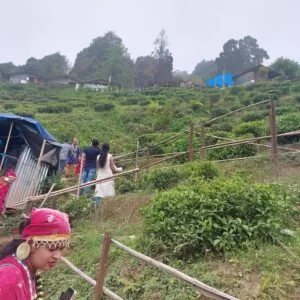Introduction
Darjeeling has some of the best tea gardens in the world. Various varieties of tea leaves are grown here. Millions of kilograms of tea are grown here every year. Many tourists visit Darjeeling tea gardens all year round. Tea gardens are a popular tourist attraction in Darjeeling. Darjeeling tea has GI tag (geographic indication tag).

Gopaldhara tea garden
Best time to visit
The best time to visit Darjeeling is between April and June. The temperatures between 20C (68F) and 25C (77F) in these months. From October to December there will be less mist.
How to get to Darjeeling tea gardens
The best way to reach Darjeeling tea gardens is by taxi. Shared taxis are cheaper than private taxis. You can get the taxis near Chowk Bazaar, Gandhi Road and other places. You can get buses near Chowk Bazaar. Based on budget one can plan their mode of transport.

Rangeet valley tea garden
Time Required for each tea garden
About 1 hour
Things to do at tea garden
Take photographs and videos
Try out the tea Pluckers dress
Taste samples of different teas
Buy some tea leaves or tea powder

Tea leaves and powder for sale
Some popular tea gardens in Darjeeling
Gopaldhara tea garden is a beautiful tea garden. This can be visited on the way back to Darjeeling from Pashupati market in Nepal. Gopaldhara produces various varieties of tea and even exports the tea. This is located in Mirik valley.

Gopaldhara
Rangeet valley tea garden is a beautiful tea garden. The broken and uneven steps need repair. One should be careful. The dresses of tea leaves Pluckers are available for a rent of about Rs.50 ($0.75). One can wear them over your dress and take photos and videos

Rangeet valley
Happy valley tea estate is about 2 km from Darjeeling Chowrasta. This is the place where one can see the tea manufacturing process. One can even taste tea sample.
Puttabong, Okayti, Makaibari and more tea estates are there in Darjeeling.
History of Darjeeling tea gardens
Darjeeling was initially a hill resort for the British. Around 1850s the British started tea gardens. Tea gardens have labor from India and Nepal to work in these Darjeeling tea gardens. In Spring, they harvest first flush, in Summer, they harvest second flush, and in autumn, they harves autumn flush.
About tea
All types of tea originate from the tea plant camellia sinensis. The two varieties are camellia sinensis var. sinensis and camellia sinensis var. assamica. The former is lighter and grows in China, while the latter is harsher and grows in India. It grows in Kalimpong.
Larger leafy grades and broken grades are two types of processed leaves. Most of the teas currently are from broken grades.
During manufacturing, producers categorize teas into fermented, semi-fermented and unfermented. They are black, green and oolong (pouching) respectively.
The tea leaves go through the process of withering that remove superficial moisture and partially dries the leaves, rolling that protects bud and produces oils, fermentation that ensures the right microbial growth and drying that removes moisture by evaporation.

Rangeet valley tea garden
Types of tea
Black tea – The leaves wither for around 10 hours, then they roll to produce enzymes and oils that interact with air to increase flavor. After that, they oxidize to turn the leaves golden brown and dry them around 80 degrees Celsius (180F).
Green tea – First, leaves dry are heated, then rolled, and then dried. They are not withered.
Oolong tea – The leaves are briefly withered, then lightly rolled, after that fermented for smaller periods of time and rolled and heated to dry.
White tea – The leaves are withered and dried. Rolling and fermentation are not done.
The other tea types are yellow tea, herbal tea and pu-erh tea.

Gopaldhara tea garden
Tourist attractions in and around Darjeeling
Tiger Hill
Toy train ride
Batasia loop
Observatory hillview point
Darjeeling ropeway
Tenzing and Gombu rocks
Rageet Valley Tea Garden
Happy Valley Tea Garden
Gopaldhara Tea Garden
Observatory
Mirik lake and garden
Pashupati market in Nepal
Mahakal Temple
Pineview point
Simanaview point
Ghum Monastery
Darjeeling Zoo and Himalayan Mountaineering Institute
Japanese Temple and Peace Pagoda
Dali Monastery
